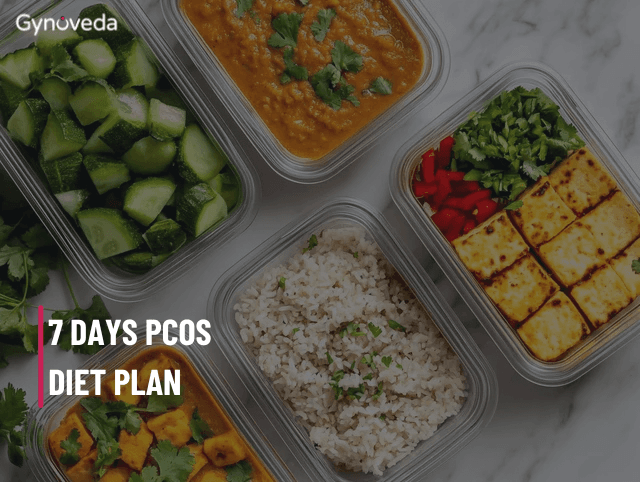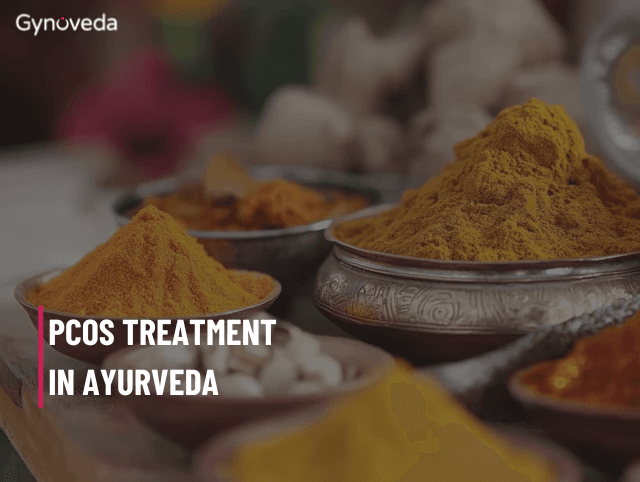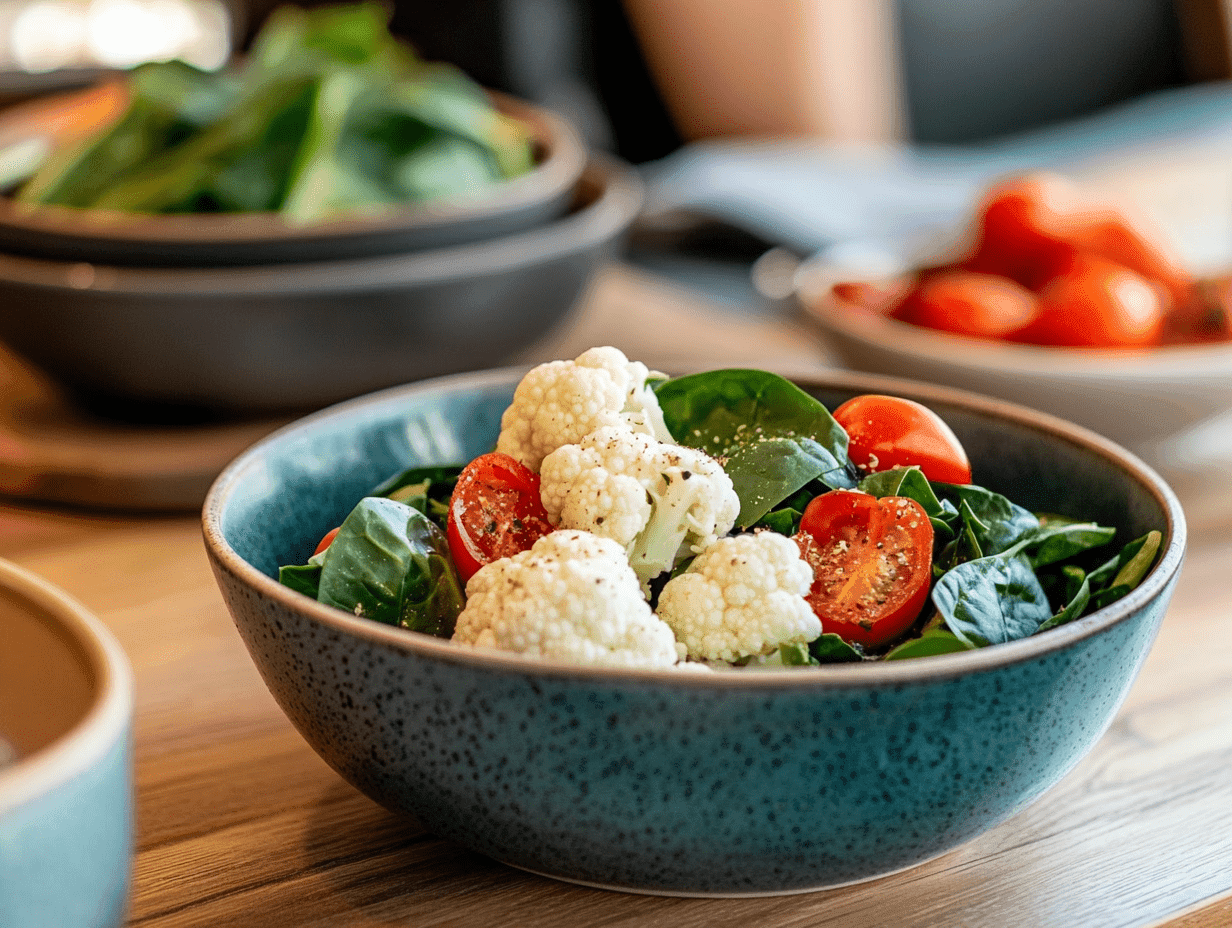7 Days PCOS Diet Chart: Foods to Eat and Avoid

A proper diet chart balances the hormones and helps address symptoms of PCOS. There are some foods that can help you regulate insulin levels. This also reduces inflammation for greater overall health. A good PCOS diet chart suggests anti-inflammatory foods. These include leafy greens, nuts, and fatty fish.
This chart will help reduce the risk of complications with PCOS. A balanced PCOS Indian diet chart compilation helps manage weight the right way. It supports reproductive health and deters symptoms like acne and hair loss. A PCOS-friendly meal plan includes foods that are high in nutrients. It enhances a person's quality of life.
Reverse PCOS symptoms naturally with gynoveda!
7-Day PCOS Diet Plan

This 7-day healthy diet chart stabilizes blood sugar, decreases inflammation, and supports hormonal balance. If you follow a balanced PCOS diet, it will help to maintain your condition and boost your energy. read the recipes below:
Day 1
Breakfast: Oats with milk
Start your day with oats and warm milk. Also, you can soak some nuts overnight and put them on top. Adding fresh and juicy apples to your breakfast gives you a burst of sweetness and extra crunch. Oats are an excellent source of energy and the richest source of omega-3 fatty acids. It also contains fiber, fats (Omega 3 and Omega 6), calcium, vitamins, and antioxidants.
Lunch: Grilled chicken salad
Marinating chicken with lime makes the chickens tastier and juicy. Take the chicken in a bowl and add all the spices and things needed for the marinade. Place all the ingredients for the salad dressing in a blend bowl. As soon as the chicken is cooked, serve it sliced by sprinkling some black pepper over all the vegetables.
Dinner: Roti with bottle gourd sabzi
Among the vegetables, bottled gourd or lauki is very nutritious and hydrating. Also, it contains more than 92% water and essential nutrients. It's a great aid in digestion, weight loss, cooling down the body, and helping to treat sleeping disorders. To make Lauki Sabzi, sauté case of cumin seeds, add ginger and chilies, then put in curry leaves. Add onions, tomatoes, spices, lauki, and water. Cook well, garnish with lemon juice and coriander, and serve hot with rotis.
Note: Gynoveda recommends that it is ideal to have dinner before 8pm.
Day 2
Breakfast: Scrambled eggs with spinach
Eggs are full of lots of nutrients and provide one of the best meals for breakfast or brunch. The spinach makes it even healthier with a lot of nutrition. It contains almost zero fat and the least cholesterol among the food groups. Add the eggs to the pot and stir occasionally as they are cooked. When done, spoon the mixture onto two plates and finally garnish the dish with the avocado.
Lunch: Rice with stir-fried paneer and cauliflower
Including paneer in one’s diet régime increases the value of the meals eaten. It contains a high source of protein, which is vital for producing antibodies. It also helps in muscle building and repair. After cooking the rice, turn off the heat and let the rice steam with the lid on. Then, add the cauliflower and other spices and stir all for 1 minute.

Dinner: Broken oats upma with green beans sabzi
Broken oats are rich in beta-glucan, fiber, and other essential nutrients. They lower blood cholesterol and improve digestion. Green beans are high in protein, vitamins, and minerals. It helps heart health, controlling diabetes, and digestion. A complete health boost from oats and green beans comes together. Prepare Oats Upma for a healthy meal. Roast oats, then saute mustard seeds, cumin, and some veggies. The next one is Green beans sabzi, where green beans are cooked with spices and potatoes. These two dishes are excellent fiber- and antioxidants-rich.
Day 3
Breakfast: Smoothie with spinach, banana, and dates
An easy vegan banana spinach smoothie consists of many rich nutrients and vitamins such as Vitamin K, A, and Potassium for your body. Pour a little milk with spinach into a blender and blend well. Pour blended baby spinach and milk while adding banana and dates until well combined.
Lunch: Brown Rice With Dal, Palak Sabzi, and Curd
Masoor dal is a great fiber, protein, and antioxidant resource, promoting heart health. Also, spinach is good at boosting immunity, strengthening bones, and enhancing vision. Curd is an excellent source of calcium, magnesium, and vitamins for digestion, skin, and hair health. To prepare the recipe, boil masoor dal in a pressure cooker with spices. Then, make palak sabzi by adding sautéed onions, potatoes, and spices, and then add palak until it is tender. This dish finds its place in the complete meal combined with brown rice and curd.
Dinner: 1 Millet roti with sautéed vegetables
Millet roti is a delicious, nutritious, and gluten-free dish. The preparation takes place through blending millet flour and chopped green leafy vegetables. Slowly adding a bit of water, knead the dough into a smooth form. Make small balls instead and shape them into thin discs. Place the roti in the skillet and let it get a golden brown color on both sides, and serve warm. For stir-fried vegetables, place a tablespoon of any neutral oil into a skillet to warm. Then add finely diced garlic and ginger, and let them fry until they smell good. Follow with chili powder, cumin, turmeric, and coriander spices, and fry for about 30 seconds. Then, add cauliflower, bell pepper, and carrot and fry until soft. Add green peas and stir around until they heat through. And here go flavorsome veggies alongside millet roti to make a whole meal.

Day 4
Breakfast: Curd (unsweetened) with nuts and seeds
Curd is also a source of calcium which is important in a balanced PCOS diet. Also, nuts can be very beneficial in shielding one’s body against free radicals. You may enrich your curd bowl with nuts, or if you prefer sweetness, add some dates on top.
Lunch: Chickpea salad with cucumber and tomatoes
Chickpea salad is good on its own but it is also extremely as versatile. Throw two cans of canned chickpeas (or make them fresh from canned chickpeas), and chop fresh vegetables. Mix them with herbs and lemon juice, and in about 20 minutes, you are ready to eat. The chickpea softens its texture, and the other ingredients add crunch and plenty of taste.
Dinner: Rice with Mushroom Curry
Fungi are rich in nutrition, low in calories, and provide lots of health benefits. Mushrooms enhance the immune system and gut health, which is important for wellness. For an easy mushroom curry, cook some onion in some oil, add mushrooms, and then add garlic and ginger. Stir in the curry powder, tomato sauce, coconut milk, and vegetable broth. Sit it down for 10 minutes, and serve with a squeeze of lime juice and some coriander.
Day 5
Breakfast: 1 cup ragi porridge and 1 boiled egg
Ragi is a great source of all three minerals-calcium, fiber, and iron. It helps in managing weight, strengthens bones, and is a benefit for general health. Eggs are wholesome proteins; they help to recover all types, including cellular types. It contains a high level of choline, which develops and enhances the memory of the brain. Prepare ragi porridge or Kantar: Soak Ragi in water. Let it cool, and mix it with buttermilk. Add cumin, onions, and curry leaves for flavoring.
Lunch: Veg pulav rice with soya chunk curry
Soya chunks produce rich proteins. These are great for the heart because they reduce harmful cholesterol and triglycerides. The preparation of soy chunks curry involves boiling and straining the soya chunks. Sauté onions, tomatoes, and spices. The water, soya chunks, peas and salt must be added before cooking for three minutes. For veg pulao, temper spices in ghee, then fry vegetables and the green masala. Pour in the soaked rice, add water, and a bit of salt. Let it cook, and once fluffy, it's all done. You know they are healthy and tasty.
Dinner: Paneer bhurji with chapati
Paneer is filled with protein, calcium, and lipids of good value. it also helps in strengthening bones and muscles and improving your health. For the preparation of this paneer bhurji, heat oil, splutter cumin seeds, and fry onions and green chilies. Pour ginger-garlic paste, allow it to cook until fragrant, then mix in tomatoes and spices. Mix in crumbled paneer, kasuri methi, and water. Simmer, garnish with coriander, and serve with chapatis.
Day 6
Breakfast: Uttapam with coriander chutney
Mix semolina, quick oats, and water to make uttapam. Add salt, vegetables, and yogurt, spices, and mix well. Heat a non-stick frying pan, brush with oil, and place batter in small dolls or pour small circle batter. Cook golden brown on both sides and serve hot. For spiced coconut chutney, blend coconut, ginger, coriander, spices, and roasted chana dal. Add tempered spices with curry leaves for aroma.
Lunch: Dalia khichdi with vegetables

To make dahlia-Ke-sabji, heat 1 tsp ghee in a pan and roast it over low flame by adding ½ cup dalia. Heat 1 tsp oil in a cooker and add 1 tsp jeera and a pinch of hing. Sauté till jeera splatters. Add ½ tsp ginger paste and 2 green chilies. Sauté for a moment. Add 1 chopped tomato and cook till soft. Add 2 tbsp peas, ½ carrot chopped, ½ tsp turmeric, and salt. Stir in ½ cup soak moong dal and sauté. Add 2 cups of water, mix, and pressure cook for 3 whistles. Serve hot with curd.
Dinner: Kidney beans curry with chapati
To prepare kidney bean curry, first, soak some dry kidney beans overnight. Pressure cook the soaked beans until soft. Then heat oil and add grated onions, freshly ground ginger-garlic paste, and spices and stir-fry until done. Add the pureed tomatoes, cover, and cook for about 15 minutes. Finally, put the before-cooked beans into the curry and simmer for 20-30 minutes on low heat. If desired, vegetables can also be added, such as carrots or peas. The protein-rich curry can be served hot with rotis.
Day 7
Breakfast: Oatmeal with nuts and sliced apple
Place cinnamon and dates on cooked oatmeal and mix all the ingredients. Top with chopped apples and nuts. If you want more fruits, then you can add some for extra crunch.
Lunch: Lentil and vegetable curry
This recipe contains iron your body uses to make Hemoglobin and Myoglobin. Wash the lentils, add them to a pot on the stovetop, and swirl them for 5 minutes. Add one small teaspoon of garam masala and turmeric and a quarter teaspoon of ginger powder to it. Cook for about 10 minutes to soften the potatoes. Sprinkle black pepper on potatoes.
Dinner: Wheat dosa with dal
To make wheat dosa, mix 1 cup wheat flour with ¼ cup rice flour, chopped onions, curry leaves, ginger, cumin, and hing in a bowl. Add 2.5 cups of water for a thin batter. Keep aside for 30 minutes and mix again. Grease a pan with heat applied, and pour the batter to cook both sides till golden. For dal, pressure-cook lentils with spices and water for 10 minutes. Whisk vigorously for creamy consistency. Serve with warm dal, and enjoy!
Drink a lot of water throughout the day. In fact, herbal teas, such as chamomile or spearmint, can help balance hormones. To reduce inflammation include turmeric and also cinnamon. To manage insulin resistance, stick to whole and natural foods high in fiber, healthy fats, and lean proteins.

Foods to Eat for PCOS
Polycystic Ovary Syndrome often results in severe hormonal balance. It also causes weight problems and general health issues. Managing symptoms relies heavily on a person’s diet. Key food groups to consider including in a PCOS-friendly diet are listed below:

High-Fiber Foods like broccoli, spinach and fruits such as berries and apples to help digest food better.
Lean Proteins like Fish, tofu, chicken, eggs, lentils, and beans to lessen your appetite.
Healthy Fats like Avocados, nuts & seeds, olive oil to boost body's metabolic functions.
Low-Glycemic Index Fruits which include whole grains, lentils, and non-starchy greens to lessen insulin spikes.
Anti-Inflammatory Foods like nuts, oats, and cherries cover inflammation and help improve insulin sensitivity.
Foods to Avoid for PCOS
PCOS diet becomes integral to managing symptoms and enhancing overall health. To regulate hormones and reduce inflammation and weight gain, you can keep certain foods out of your diet. But this guide also highlights what you should avoid eating for better PCOS management.
Refined Carbohydrates and sugars as they increase inflation and negatively affect overall health.
Sugary Drinks and Snacks that are high on the Glycemic Index (GI) scale
Processed Foods and Trans Fats
Dairy and Red Meat (in moderation)
Tips for Sticking to a PCOS Diet
Adhering to a PCOS diet is not easy but very much beneficial for you and your health. In this case, adherence to the correct strategies results in better health and enhanced symptoms. Below are some tips to help you on your way to PCOS diet success.
Meal Prep and Planning
Meal prepping for PCOS is an effective way of having pre-planned and perfectly cooked foods. Check that you do not end up making meals that are not suitable for your PCOS diet by eating them beforehand. Include tips to save time for healthy eating, cooking in large batches, or portioning.
Stay Hydrated
Staying hydrated is important for improving the health of a woman with PCOS. Replace sugary sodas with water or sugar–free beverages. There is also a long list of other options, such as herbal teas being a preferred option.
Practice Portion Control
Avoid portion control so that you don’t take more than your body can handle. Proper dieting can help you to manage your weight as well as maintain a healthy hormonal balance.
Conclusion
In conclusion, healthy diet planning for women with PCOS can effectively manage the disease. The nutritionists confirm that it regulates hormones and insulin and reduces inflammation. Using the benefits of a PCOS diet chart provides better control of weight and fewer health complications. Include foods with anti-inflammatory nutrients and fatty acids. Avoiding unhealthy choices also helps you manage your PCOS as well. See diet as a management regime and keep consistency in managing PCOS for the general well-being.
consult gynoveda for expert recommendations!
References-
Amanda Stathos, PCOS Diet, Johns Hopkins Medicine
Danielle Dresden, (July 24, 2023), What to eat if you have PCOS, Medical News Today
You May Like

PCOS Treatment in Ayurveda: Complete Guide

Top 10 Tips to Get Pregnant with PCOS Quickly

Top 10 PCOS Symptoms in Unmarried Girls - How to Improve Naturally

Tips for Weight Loss in 1 Month with PCOS: Dietary & Lifestyle Changes

Top 15 Hormone Balancing Foods for Natural Wellness
Frequent Asked Questions
In some women with PCOS, dairy might just worsen hormonal imbalances, which may cause acne or more inflammation.
High-sugar fruits like bananas and grapes should be eaten in moderation, as they can spike insulin levels.
While the diet itself may not cure PCOS, it can play a big role in not only managing symptoms but in bringing hormones into balance as well.
Although intermittent fasting may aid in weight management and improve insulin sensitivity in PCOS, but should be done with caution.
In some women with PCOS, gluten sensitivity can contribute to inflammation or weight, making them worse.
Cheat meals for PCOS may not be harmful sometimes, but maintaining a healthy diet is essential for the long-term management of PCOS.

Success Stories with Gynoveda across India
Talk to Gynoveda Today


